|
Örjan Martinsson
| |
|

Information about Russian uniforms for the first half of the Great Northern
War is unfortunately in short supply since the Russian army lost their
archives during their failed campaign against the Turks at Prut in 1711.
In addition to that most Russian regiments did not have stable uniform
colours during this period and they frequently changed colours each time they
received new uniforms. All this means that any attempt to illustrate Russian
uniforms in the battles of the Great Northern War will inevitable be more or
less speculative. This is also true for the images on this page which should
be viewed as qualified guesses on how the uniforms looked like in the
battle of Poltava (and in some cases also their Eastern uniforms
in the battle of Narva).
For a long time there was no good literature available on this subject
since for example the Osprey books covering Peter the Great's army by Angus Konstam
(1993-94) got its information from A. V. Viskovatov's Russian-language work from
the 19th century, which has proven to be a very unreliable source.
Thorough archive research resulted however in a Russian-language book on the
Russian army 1700-1730 by K. V. Tatarnikov in 2008 and its uniform data is
since 2018 available in English in the book "The Russian Army in the Great Northern War 1700-21"
by Boris Megorsky. It is the latter book that is my main source to my pages
on Russian uniforms. But alongside Megorsky's information I have also
included information from Lars-Eric Höglund and Alexander Bespalov's book
"Stora nordiska kriget 1700-1721, III" from 2004. In those
cases Höglund/Bespalov
have uniform data that is not mentioned by Megorsky it usually means they
got it from Viskovatov which, as previously stated, is not a reliable
source. But for anyone who wants to paint miniature figures, unreliable
information is still better than no information at all.
Russian Uniforms in General
In the beginning
of the Great Northern War the Russian army still used Eastern style uniforms
and it was not until December 1702 the first Western style uniforms began to
be issued. Because coats were only replaced about every third year, it was
not until 1705 when Western uniforms had fully replaced the older uniforms.
During the transition period regiments could be seen wearing a mix of
Eastern and Western equipment such as a Western coat but a cap trimmed with
bearskin and older boots.
The earliest
Western coats may have had double rows of buttons (similar to Danish coats) but in 1708 the Preobrazhenski Guard was to be issued coats with a
single row of buttons and the rest of the army followed their example.
Although as late as 1711 there were still several regiments with double
breasted coats. The buttons on the early coats were covered with cloth but it
then became standard that the infantry was to have pewter buttons while
grenadiers and dragoons were to have brass buttons.
Initially the
coats did not have a collar at all or a standing collar in the same colour
as the coat. A falling collar was introduced for the artillery 1704, for dragoons 1706
and for the Guard in 1712.
There was a
considerable variation in colours but from 1708 it was decided that green
was the preferred colour on an infantry coat. A shortage of cloth with the
right colour meant however that the regiments had to settle for whatever was
available and the colour could change dramatically each time the regiment
was issued new uniforms.
|
|
Preobrazhenski
Guard
Colonel: Tsar Peter
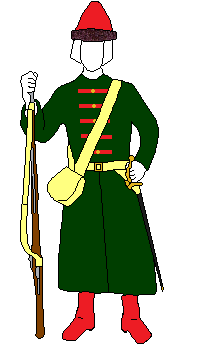 |
1700 |
Dark green Hungarian coat and red boots. |
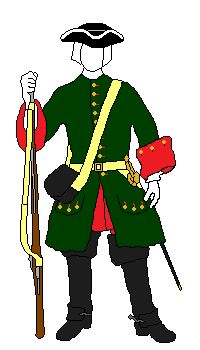 |
|
March 1701 |
Green coat lined with fur, red cap trimmed with
sable fur.
|
|
Dec. 1702 |
Dark green French coat with red cuffs, buttons
covered with uniform cloth, hat with broad brim trimmed with white
lace, grenadier bearskin caps. |
|
1703 |
Dark green French coat, red cuffs, vest and
breeches. Hat with lace. German bombardier caps with wide black
trimming. |
|
1706 |
Hats which by mistake had four corners instead of
three. hat lace from rotten coats. |
|
1707 |
Grenadier caps with fur (bear or beaver)
and red top. |
|
1708 |
Coat with single row of buttons. |
|
1711 |
Red collar. |
|
1712 |
Leather grenadier caps with pewter plates. |
|
1720 |
Dark green coat, red collar and cuffs, green cloak.
Officers had all dark green coats with gold lace on collar and
cuffs. |
According to Boris Megorsky (page 165) the Guard regiments were mounted 1707-1713
and had at that time cavalry equipment (boots instead of shoes) despite
the fact that they with just one exception always fought on foot.
According to Höglund/Bespalov the uniform for "1698?"
consisted of a red fur brimmed cap, green kaftan with brass buttons, red
vest, green breeches and boots. Officers had gold buttons and gold lace
on their coats. For the period 1702-1720 they state that the privates
had: hat with yellow lace alternatively green karpus with red
lining, green coat with brass buttons and red lining, cuffs vest,
breeches and stockings. They also mention that other sources states
green vests & breeches sand white stockings instead. Officers had
hats with gold lace and coats with gold lace and gold buttons.
Azov campaigns 1695-96, Narva 1700, Nöteborg 1702, Nyenskans 1703,
Narva 1704, Lithuania 1704-06, Malatitze 1708, Lesnaya 1708, Oposhnaya
1709, Poltava 1709, Riga 1710, Stettin and Wismar 1712, Tönningen 1713,
Copenhagen 1716. |
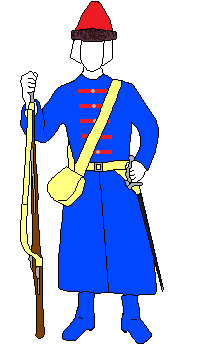 |
Semenovski
Guard
Colonel: M. Golitzin
|
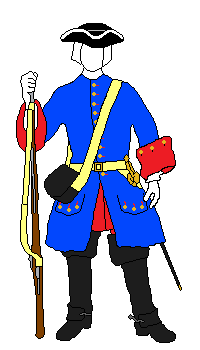 |
|
Dec. 1702 |
Dark blue or azure coloured French coat with red
cuffs, buttons covered with uniform cloth. |
|
1703 |
Light blue French coat with red cuffs, vest and
breeches. |
|
1704 |
Blue coat. Hat with white lace. |
|
1707 |
Grenadier caps delivered from Preobrazhenski
Guard. |
|
1709 |
Each coat should have 26 brass buttons. White
neckcloth. |
|
1711 |
Red collar. |
|
1712 |
Leather grenadier caps with pewter plates. |
|
1720 |
Dark green coat, blue collar, red cuffs, blue cloak.
Officers had all dark green coats with gold lace on collar and cuffs. |
According to Boris Megorsky (page 165) the Guard regiments were mounted 1707-1713
and had at that time cavalry equipment (boots instead of shoes) despite
the fact that they with just one exception always fought on foot.
According to Höglund/Bespalov the uniform for "1698?"
consisted of a red fur brimmed cap,, blue kaftan with pewter buttons,
red vest, blue breeches and boots. Officers had silver buttons and
silver lace on their coats. For the period 1702-1720 they state that the
privates had: hat with yellow lace, blue coat with brass buttons and red
lining, cuffs, vest,
breeches and stockings. They also mention that other sources states blue
vests & breeches and white stockings instead. Officers had hats with gold
lace and coats with gold lace and gold buttons.
Azov campaigns 1695-96, Narva 1700, Nöteborg 1702, Nyenskans 1703,
Narva 1704, Lithuania 1704-06, Malatitze 1708, Lesnaya 1708, Oposhnaya
1709, Poltava 1709, Riga 1710, Stettin and Wismar 1712, Tönningen 1713,
Copenhagen 1716. |
Repnin's
Grenadier Regiment
According to Boris Megorsky
|
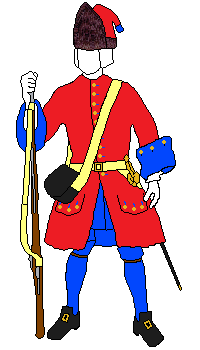 |
According to
Höglund/Bespalov
|
| |
1708: Tailor
1709: Peter Lacy
1711: Andrey de Brilli
|
1708: Taylor
1708-25: P. Leslie and P. Baryatinski |
|
1709 |
Red coat. Caps |
1711
Red coat and grenadier cap trimmed with
bearskin |
|
1713 |
Hats for train drivers. |
|
1715 |
Caps. |
1715
Green coat and green cap with red lining. |
|
1716 |
Blue stockings |
|
1718 |
Caps with covers. |
1717
"With blue livery" |
According to Megorsky the regiment was formed in 1708 with the grenadier
companies from the regiments in Repnin's infantry division: Butyrski, Belgorodski,
Nevski, Nizhegorodski, Pereyaslavski, Tverski, Schlüsselburgski,
Yamburgski and Yaroslavski. According to Höglund/Bespalov the grenadier
company from Narvski Regiment was also a part of Repnin's Grenadier
Regiment. Megorsky also states that Yaroslavski and Butyrski regiments
retained their grenadiers until 1711 and 1713 respectively.
Lithuania 1708, Oposhnaya 1709, Poltava 1709, Riga 1710, Prut 1711,
Pomerania
1712-14, Finland 1716-17, naval infantry 1718-20. |
|
Weide's
Grenadier Regiment
According to Boris Megorsky
|
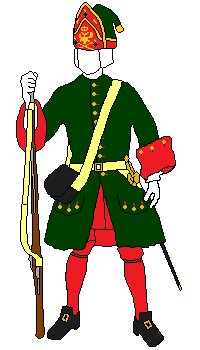 |
According to
Höglund/Bespalov
|
| |
1708: Yury Bush
1711: Adam Weide
|
1708: J. Busch
1715: General Weide |
|
1711 |
Green coat. Caps with
covers |
1711
Blue cap with red lining and blue coat. |
|
1712 |
Caps with eagles, red
neckcloth, green coat, brass buttons with eagles, red breeches and
stockings |
|
1715 |
Green coat with red
cuffs and brass buttons. green breeches, red and blue cloak, red
neckcloth, caps with covers (officer caps were embroidered with
gold). Two colours. |
|
1716 |
Caps with covers |
1716
Blue cap with red lining. Green coat with
red lining, cuffs, vest and breeches. Black neckcloth and blue cloak.
|
|
1718 |
Dark green coats,
leather breeches, white stockings, dark green cloak, black neckcloth,
caps. |
|
1719 |
White stockings. |
|
1720 |
NCOs' gloves made of
goat leather. |
|
1721 |
Dark green coat,
breeches made of chamois leather. |
According to Megorsky the regiment was formed in 1708 with the grenadier
companies from
Belozerski, Lefortski, Vyatski, Kievski, Rentzel, Rostovski, Tobolski,
Olonetski and Koporski regiments. Höglund//Bespalov mention the same
regiments but also includes Ivangorodski.
According to Megorsky "First Grenadier Regiment" was an
alternative name for this regiment since it belonged to the First
Infantry Division. But Höglund/Bespalov states "Second Grenadier
Regiment" as an alternative name.
Holowczyn 1708, Oposhnaya 1709, Poltava 1709, Riga 1710, Prut 1711,
Pomerania 1711-1719. |
|
Enzberg's
Grenadier Regiment
According to Boris Megorsky
|
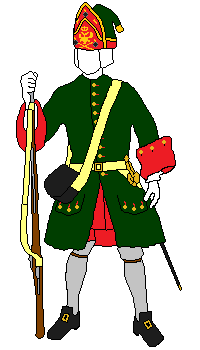 |
According to
Höglund/Bespalov
|
| |
1708: von Adonow
(?)
1710: Ivan Campenhausen
|
1708-09: de Bois
1712-25: Kampenhausen |
|
1709 |
Dark green coat and red
breeches. Caps |
Wore at an unknown time
green coat, red vest and light blue cloak. |
|
1711 |
Dark green coat |
|
1713 |
Green coat, leather
breeches, grey stockings. Hats and caps. |
|
1714 |
Caps. |
|
1715 |
Green coat. |
|
1717 |
Green cloak. |
|
1718 |
Red coat, leather
breeches, green cloak and red neckcloth. |
According to Megorsky the regiment was formed in 1708 with the grenadier
companies from Velikolutski, Vyatski, Voronezhski, Chernigovski,
Ryazanski
regiments.
Höglund/Bespalov also includes Narvski and Permski. The latter grenadier
company was according to Megorsky instead a part of the Second Grenadier
Regiment 1709-1711.
According to Höglund/Bespalov this regiment was also called the Fourth
Grenadier Regiment in 1712.
Kolkanpää 1708, Oposhnaya 1709, Poltava 1709, Viborg, 1710, Reval 1710,
Prut 1711. |
|
Hallart's
Grenadier Regiment
According to Boris Megorsky
|
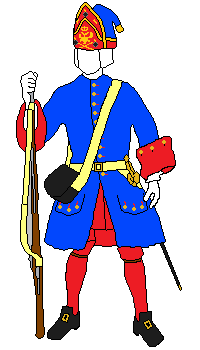 |
According to
Höglund/Bespalov
|
| |
1708: Efim Boeck
1710: Leinrot
1711: Alexander Frazer
1712: Ivan von Mengden
1717: Denis Biels
|
1708: Bieltz
(Bils)
1709: Bock
1711: de Bon
1715: von Mengden |
|
1708 |
Caps. |
1711
Blue coat and cap. 1715
Green coat with red lining and cuffs. Green grenadier cap trimmed
with
bearskin.
1717
"Red outfit with blue cloaks" |
|
1709 |
Caps. |
|
1711 |
Caps. Blue coat |
|
1712 |
Caps. |
|
1714 |
Caps. |
|
1717 |
Caps. Red coat. Blue
cloak. |
The regiment was formed in 1708 with the grenadier companies from Kazanski, Kargopolski, Moskovski, Novgorodski, Pskovski, Sibirski, Ustyuzhski
regiments.
Because the regiment was part of Hallart's division it is also called Hallart's
Grenadier Regiment 1708-1716. It was also known as the First Grenadier
Regiment in 1721 because it was the oldest of the two
grenadier regiments in Finland.
Holowczyn 1708, Oposhnaya 1709, Poltava 1709, Riga 1710, Prut 1711,
Pomerania 1712-1713. |
|
Second
Grenadier Regiment
According to Boris Megorsky
|
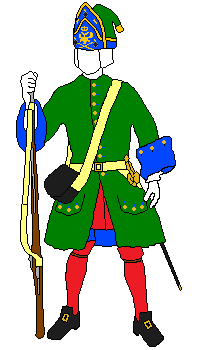 |
(Not
mentioned by
Höglund/Bespalov)
(Angus Konstam refer to it as Baryatinski's Grenadier Regiment) |
| |
1710: Ilya
Lutkovsky
1714: Denis Biels
1717: Ivan Baryatinsky
|
|
1711 |
Brass buttons with
eagles. Red vest and stockings |
|
1714 |
Caps. |
|
1716 |
Green coat, red vest,
blue cloak and breeches. NCOs and corporals had coats with gold and
silver lace. |
|
1717 |
Red vest, blue breeches,
caps, blue facings |
|
1718 |
White neckcloth. |
|
1719 |
White neckcloth |
|
1720 |
Green coat, red vest,
blue breeches and cloaks. Knitted gloves for NCOs. Caps with covers |
The regiment was formed in May 1709 with the grenadier companies from Apraxin's, St.
Petersburgski, Inglis' (Viborgski) Permski, Troitski and von Fichtenheim's
regiments. All regiments were stationed in Saint Petersburg and its
surroundings but managed to arrive in time for the battle of Poltava.
Immediately afterwards the regiment was disbanded just to be resurrected
in January
1710. At that time the grenadier companies came from Arkhangelgorodski,
Belozerski, Vladimirski, Smolenski and Chemer's regiments. In 1711
the companies from Permski and Chemer were returned.
This regiment is usually called the Second Grenadier Regiment because it
was the younger of the two grenadier regiments stationed in
Finland. |
Arkhangelgorodski
(raised 1700 in Kazan through
conscription)
|
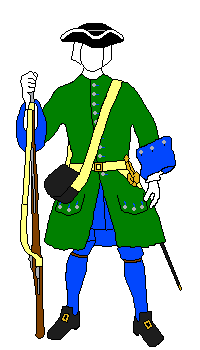 |
| |
1700: Zachary
Krog,
1702: Roman Bruce
|
|
1706 |
Hat. |
|
1708 |
Green coat with blue |
|
1710 |
Hat. |
|
1711 |
Hat. |
|
1712 |
Hat. |
|
1713 |
White breeches. One
white and seven azure colours |
|
1715 |
Karpus |
|
1716 |
Blue coat with blue
lining, red cuffs and collar, brass buttons, blue breeches, red
cloak with blue lining, blue karpus with green flaps. |
|
1717 |
White coat, red cloak.
Delivered: Blue coat with red lining, cuffs and collar, brass
buttons, red vest, blue breeches and red cloak with blue lining. |
|
1718 |
Blue coat, red vest,
blue
karpus. |
|
1720 |
Karpus. |
|
1721 |
Green vest and red cloak. |
Düna 1701, Nöteborg 1702, Nyenskans 1703, garrison in Saint
Petersburg 1703-06, Kexholm 1710, Viborg 1710, Pälkäne 1713, naval
infantry
1714-15, garrison in Åbo (Turku) 1716-17.
|
Astrakhanski
(raised 1700 in Moscow through
conscription) |
According to Boris Megorsky
|
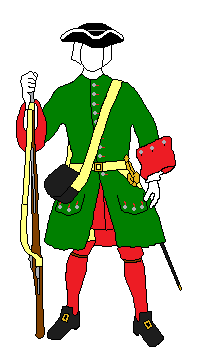 |
According to
Höglund/Bespalov
|
| |
1700: Alexander
Gordon
1704: Mikhail Sheremetev
|
1700:
A. Gordon
1701: J. Scott
1704: N. Ifflandt
1706: M. Sheremetev1711
Green coat with red lining and cuffs,
leather breeches. |
|
1700 |
Dark green coat. |
|
1708 |
Red cloak |
|
1711 |
Green coat, leather
breeches. |
|
1715 |
Leather breeches, hats,
grenadier caps. Eight large old white colours including one with
eagle, eight green standards with yellow fringe including one with
eagle, two large red colours with the text "Za Veru i Khristianstvo",
eight green colours including one white with eagle. Delivered in
Pomerania: eight green colours
including one with eagle, made in Königsberg. |
|
1717 |
Dark green coat, leather
breeches, hats and grenadier caps. |
|
1719 |
Leather breeches,
grenadier caps. |
|
1720 |
Red cloak. |
|
1721 |
Hat. |
Just like the guard regiments, Astrakhanski retained their
grenadiers after the creation of grenadier regiments. Astrakhanski
might have had cavalry boots instead of shoes when they became mounted
together with the guard regiments 1707-08.
Narva 1700, Nöteborg 1702, Jamburg 1703, Dorpat 1704, Narva 1704, Grodno
1706, Holowczyn 1708, Lesnaya 1708, Oposhnaya 1709, Poltava 1709, Riga
1710, Prut 1711, naval infantry 1713-16. |
|
Azovski |
According to Boris Megorsky
(raised 1700 in Moscow by volunteers)
|
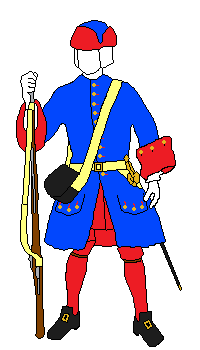 |
According to
Höglund/Bespalov
(raised in Kazan 1700 through
conscription) |
| |
1700: Matvey
Treiden
1702: Tikhon Gundertmark
1704: Yury Busch
|
1700: I. Busch
|
|
1704 |
Blue coat, red vest and
breeches, grenadier bearskin caps. |
1717
Green coat, red cloak.
Regiment raised in Moscow 1700 by
volunteers:
1700: M. Treiden
1701: T. Gundertmark Unknown uniform |
|
1707 |
Grenadier caps of red
cloth embroidered with silk. |
|
1709 |
Karpus. |
|
1710 |
Brass buttons. |
|
1713 |
Karpus. |
|
1715 |
Karpus. |
|
1717 |
Green coat, red cloak. |
|
1718 |
Karpus. |
|
1720 |
Knitted gloves for NCOs. |
According to Megorsky the regiment that would become Azovski was
in 1702 split in two. Höglund/Bespalov records this predecessor as a
separate regiment which was disbanded 1703 and had its men redistributed
to two new regiments commanded by Gundertmark (Schlüsselburgski)
and Busch.
Azovski Regiment retained their grenadiers until 1711.
Höglund/Bespalov's Kazan regiment: Düna 1701, Nyenskans 1703,
Narva 1704, garrison in Narva and Saint Petersburg 1704-09, Viborg 1710,
Reval 1710.
Höglund/Bespalov's Moscow regiment: Narva 1700, Erastfer
1701, Hummelshof 1702. |
|
Belgorodski
Raised 1696-97 in Belgorod with men from
other regiments (Preobrazhenski and Semenovski according to Höglund/Bespalov).
Colonel: Saava Aigustov (from 1698)
|
1709 |
Dark green coat, breeches of leather
and red cloth, red stockings, hat with lace, red neckcloth. |
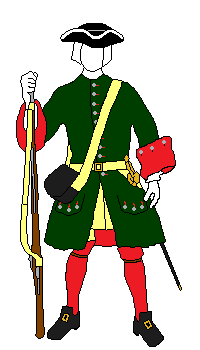 |
|
1710 |
Dark green coat with red cuffs,
pewter buttons with eagles, red breeches and cloaks, hats with white
lace. |
|
1711 |
Blue coat with red cuffs and blue
lining, red neckcloth, boots. Two colours: one white with eagle and
one green with diagonal lines in black and white. |
|
1712 |
Blue coat, yellow karpus with red
lining, white stockings, black neckcloth. The colonel's colour white
with the Tsar's cipher in gold surrounded with palm leaves, seven
company colours quartered in black and green with red stripes in
between and stitched with yellow, emblem painted in gold: lion
escapes from eagle. |
|
1713 |
White stockings, gaiters |
|
1714 |
Blue coat with red cuffs and dark
green lining, brass buttons. NCOs and corporals had gold lace on
their coats. |
|
1716 |
White stockings. |
|
1717 |
Dark green coat with red lining.
NCOs and corporals had gold lace on their coats. Leather breeches,
grey stockings, green karpus with red flaps, black neckcloth. |
|
1718 |
Blue coat with red lining. |
|
1719 |
1312 green coats including 982 with
red lining. NCOs and corporals had gold lace on their coats. 1152
dark green breeches, 160 red breeches, green karpus with red flaps,
red neckcloth. |
Garrison in Belgorod and Voronesh 1698-1700, Erastfer 1701,
Hummelshof 1702, Jamburg 1703, Dorpat 1704, Narva 1704, Grodno 1706,
Poltava 1709, Riga 1710, Prut 1711, Stettin 1713.
|
|
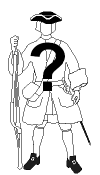 Belozerski Belozerski
(Raised 1700 in Kazan through
conscription)
1700: I. Berner
1706: A. Golitsyn |
Unknown uniform
Nöteborg 1702, Nyenskans 1703, Narva 1704, garrison in Saint
Petersburg 1704-09, Poltava 1709, garrison in Saint Petersburg from 1712.
|
|
Butyrski
(Raised 1656 in Moscow as the
second
Vyborny regiment. According to Höglund/Bespalov it was raised
already in
1642.)
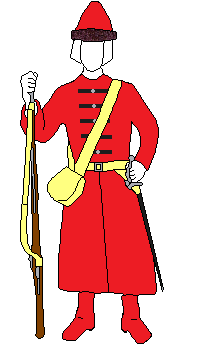 |
Colonel: James Gordon
(se below)
|
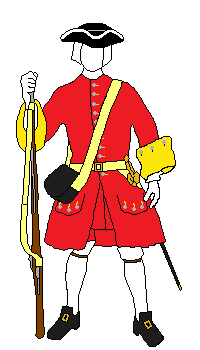 |
|
1700 |
Red coat. |
|
1705 |
Red colours. |
|
1707 |
Red coat. |
|
1709 |
Hat. |
|
1711 |
Red coat, red breeches. boots, hat, red or yellow
karpus with red lining. |
|
1712 |
Red coat, red breeches, white stockings, hat, red
or yellow karpus with red lining. |
|
1713 |
Gaiters of tent linen. Left the regiment: 100 red
grenadier caps with blue flaps and black tassels, badges of white
cloth with gilded eagle over it. Three light blue
officer grenadier caps embroidered with gold and silver. 190
Grenadier bags of black leather with brass badges and crowns |
|
1714 |
Red coat with yellow cuffs and lining, red vest. |
|
1717 |
Red coat (English uniforms), karpus. |
|
1718 |
Red coat and leather breeches. |
According to Höglund/Bespalov the colonels were: J. Gordon until 1705,
then A. Repnin 1705, I. Busch 1705, Solnzev-Zasekin 1706.
Azov campaigns 1695-96, Narva 1700, Nöteborg 1702, Nyenskans 1703,
Narva 1704, Poland-Lithuania 1705-06, Oposhnaya
1709, Poltava 1709, Riga 1710, Prut 1711, Stettin and Wismar 1712, Tönningen 1713,
Copenhagen 1716. |
|
Galitski
(raised 1704 in Nizhny Novgorod from
garrison soldiers)
|
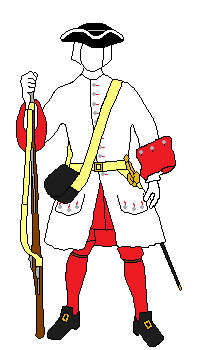 |
(Not
mentioned by
Höglund/Bespalov)
Although
they do mention another regiment raised 1700 in
Moscow by volunteers which was merged with Galitski 1712.
|
| |
1704: Ivan Stubensky
|
|
1705 |
White colours |
|
1711 |
White coat with red
facings |
|
1717 |
Green coat. |
|
Chernigovski
(raised in Moscow 1700 by volunteers)
1700: William von Schweiden
1704: Yury Shkot
1705: Petr Gassenius
|
|
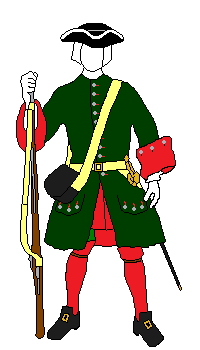 |
|
1710 |
Dark green coat. |
|
1711 |
Dark green coat, green
breeches, hat. Two companies stationed in Kiev had red coats and
white breeches. |
|
1712 |
Green and white coat,
red breeches, blue and red cloak, hat. |
|
1713 |
White coat with red
cuffs and lining, white vest, leather breeches, white stockings,
gaiters, hat, red neckcloth. |
|
1714 |
83 red coats (probably
for NCOs), grey stockings. |
|
1715 |
Red coat with blue cuffs
and lining, white stockings, karpus, red neckcloth. |
|
1717 |
Blue cloak with red
lining. |
|
1718 |
Blue coat with red cuffs
and lining, leather breeches, blue cloak, hat. |
|
1720 |
Red cloak with blue
lining with brass hooks and loops. |
Narva 1700, Erastfer 1701, Hummelshof 1702, Jamburg 1703, Dorpat
1704, Narva 1704, Grodno 1706, Poltava 1709, Prut 1711, Pomerania 1711-14.
|
Ivangorodski
(raised 1700 in Kazan and disbanded 1712)
Was a garrison regiment in Belgorod,
Polotsk and Kiev 1700-1708. Participated in the siege of Riga 1710
and the Prut campaign 1711.
According to Boris Megorsky
|
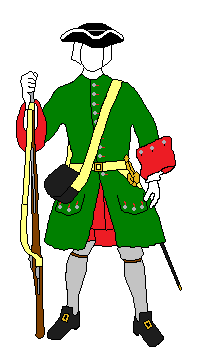 |
According to
Höglund/Bespalov
|
| |
1700: Andrey
Mitchel
1705: Andrey Romanovsky |
1700: A. Mitchell
1705: A. Romanovski
1708: Rauch
|
|
1711 |
Green coat, red breeches,
hat. |
1711
Green coat with red cuffs and lining, red
vest, red breeches and stockings, black hat. |
|
1712 |
Green coat with pewter
buttons, red breeches, grey stockings, red neckcloth, hat. |
|
|
Ingermanlandski
(raised 1703 in Saint Petersburg with
chosen men from other regiments)
Colonel:
Alexander Menshikov
According to Boris Megorsky
|
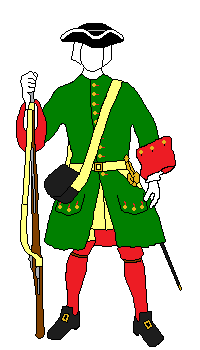 |
According to
Höglund/Bespalov
|
|
1704 |
Grey coat, Light blue
colours. |
1703
Hat with white lace, grey coat with brass
buttons, blue lining and cuffs, grey vest, blue breeches, grey
stockings, black neckcloth.
1706
Yellow coat with red lining and cuffs, brass
buttons. red vest, breeches and stockings.
1710 Yellow coat as in 1706, leather
vest and leather breeches, red cloak.
According to Megorsky it was planned
that Ingermanlandski should have yellow coats n 1706, but these were
never delivered.
1717
Green coat with red lining and cuffs. |
|
1705 |
Yellow colours. |
|
1707 |
Green coat with red
cuffs as in Preobrazhenski. |
|
1709 |
Red cloaks. |
|
1710 |
Leather vest,
leather breeches, red cloak, coat with single row of buttons. |
|
1711 |
Leather vest, leather
breeches, red cloak, hat. Eight dragoon colours and during the
Turkish campaign one infantry colour and two dragoon colours were
delivered. |
|
1712 |
Red cloak. |
|
1713 |
Blue coat, white vest
and white breeches, hat. |
|
1714 |
Red cloak. |
|
1715 |
Green coat, leather
breeches,
hat, grenadier caps |
|
1717 |
Green coat with red
facings, Blue cloak, hat with (white?) paper rosette.. |
|
1718 |
Red coat, leather
breeches,
hat. |
|
1720 |
Red cloak. |
Ingermanlandski Regiment consisted of three battalions and had the
same pay and benefits as the guard regiments. Just like them
Ingermanlandski also retained their grenadiers even after the creation
of grenadier regiments. They might have had cavalry boots instead of
shoes when they together with the guard regiments became mounted 1707-08.
Dorpat 1704, Narva 1704, Mitau
1705, Grodno 1706, Holowczyn 1708, Lesnaya 1708, Poltava 1709, Riga 1710,
Prut 1711, Pomerania 1712, Hangö udd (Gangut) 1714, Stäket 1719. |
Not mentioned by Boris Megorsky
According to
Angus Konstam
(raised 1702/03 and disbanded 1712))
Colonel: Stekalov |
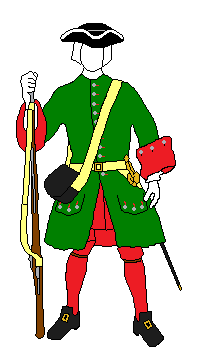 |
Kargopolski
According to
Höglund/Bespalov
Raised 1706 in Saint Petersburg with
streltsies from the regiments Strekalov, Sucharev, Elchianov, F.
Bashnev and M. Bashnev (disbanded 1713)
Unknown colonel
1708/09
Green coat, black hat and grey cloak.
Viborg 1706, Oposhnaya 1709, Poltava 1709, Riga 1710,
Prut 1711, Pomerania 1713. |
|
Kazanski
(raised 1700 in Moscow by volunteers)
According to Boris Megorsky
|
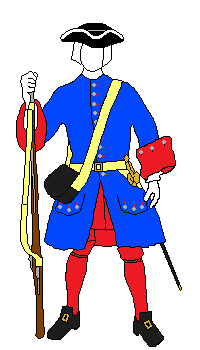 |
According to
Höglund/Bespalov
|
| |
1700: Ivan von
Delden
1705: Ludwig Hallart
|
1700: J. von
Delden
1706: L. Hallart |
|
1709 |
Hat. |
1700
Green coat.
1711
Blue coat with pewter buttons, red lining
and cuffs, blue karpus with red lining, red neckcloth.
1716 Green coat.
1717
Blue coat, blue cloak. |
|
1711 |
Blue coat, red karpus
with blue lining. |
|
1712 |
Blue coat, red karpus
with blue lining. |
|
1714 |
Karpus. |
|
1717 |
Green coat until September,
thereafter blue. Karpus, blue cloak. |
|
1718 |
Leather breeches |
|
1721 |
Knitted gloves for NCOs
and corporals. |
Narva 1700, Erastfer 1701, Hummelshof 1702, Jamburg 1703, Dorpat
1704, Narva 1704, Grodno 1706, Oposhnaya 1709, Poltava 1709, Riga 1710,
Prut 1711, Pälkäne 1713, Storkyro 1714, naval infantry 1714-19, Stäket
1719. |
|
Kievski
(raised 1700 in Moscow through
conscription)
According to Boris Megorsky
|
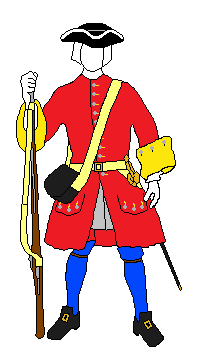 |
According to
Höglund/Bespalov
|
| |
1700: William von
Delden
1701: Christopher Zimmerman
1702: Joachim Goulitz
1703: Nikolay Goering
1705: Boris Sheremetev
|
1700: W. von
Delden
1701: K. Zimmermann
1703: J. Gulitz
1703: N. Göring
1704: B. Sheremetev
|
|
1710 |
Red coat with yellow
cuffs, red breeches, blue stockings, red cloak, hat. |
1700
Green coat. 1708
Yellow coat.
1711
Hat, red coat with pewter buttons, yellow
lining and cuffs, grey vest, red breeches, grey/yellow-striped
stockings and red cloak. |
|
1711 |
Red coat with yellow
cuffs, red breeches and cloaks, hat. |
|
1712 |
Hat. |
|
1713 |
White stockings, hat,
black neckcloth. |
|
1714 |
Red coat |
|
1715 |
Hat, red, neckcloth,
grey coat for train drivers, blue cloak with red lining, white and
grey stockings. |
|
1716 |
Blue coat with white
facing and lining, brass buttons for NCOs and pewter for privates,
blue breeches, hat. |
|
1718 |
Blue cloak with red
lining, red neckcloth |
|
1719 |
Blue coat with red cuffs
and lining, brass buttons, gold lace for NCOs, blue breeches, blue karpus
with red lining, hats for NCOs and corporals. |
|
1721 |
Vest and breeches blue. |
Narva 1700, Erastfer 1701, Hummelshof 1702, Nyenskans 1703,
Jamburg 1703, Dorpat 1704, Narva 1704, Grodno 1706, Oposhnaya 1709,
Senzhary 1709, Poltava 1709, Riga 1710, Pomerania 1711-13. |
|
Koporski
(raised 1703 in Kazan from garrison soldiers)
1703: Afanasy
Skripitsyn, 1706: Alexey Golovin
According to Boris Megorsky
|
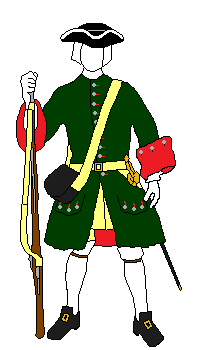 |
According to
Höglund/Bespalov
|
|
1703 |
Green coat, grey cloak,
black hat. |
1703
Green coat with red lining and cuffs, red
breeches, red stockings, grey cloak.. 1711
Hat, green coat with red lining and cuffs,
leather breeches, red stockings, grey cloak. |
|
1710 |
Dark green coat,
leather breeches, grey homespun cloak |
|
1711 |
Dark green coat,
leather breeches, grey homespun cloak, pewter buttons, red breeches,
white stockings. |
|
1712 |
Dark green coat, red
breeches, white stockings, train drivers' coat grey and vest of
coloured linen, hat, red neckcloth. |
|
1713 |
Blue cloak with brass
hooks and loops. |
|
1714 |
Blue coat, leather
breeches,
karpus, red neckcloth. |
|
1716 |
Red coat, leather
breeches,
blue cloak, green karpus, red neckcloth. |
|
1717 |
Coat (or maybe just
facings) blue |
|
1718 |
Red coat, breeches blue
and leather, cloak red, green and blue, karpus green. Colours: green
with emblem
and iron finials, two yellow, two reddish, one red with brass gilded
finial, one grey, one white with eagle. |
|
1719 |
Blue coat, leather
breeches, red karpus, black neckcloth. |
|
1720 |
Blue coat with red cuffs,
leather breeches, cloaks of various colours, red karpus, black
neckcloth, green fourier pennants. |
Narva 1704, Lithuania 1705-07, Holowczyn 1708, Oposhnaya 1709,
Poltava 1709, Riga 1710, Prut 1711, Finland 1714. |
|
Lefortski
(Raised 1656 in Moscow as the
first
Vyborny regiment. According to Höglund/Bespalov it was raised
already in 1642.)
According to Boris Megorsky
|
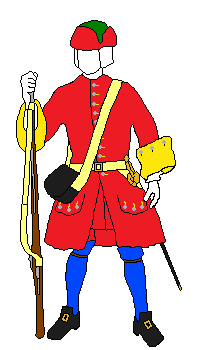 |
According to Höglund/Bespalov
1699: F.
Lefort
1700: A. Weide
1701: J. de Lima
1704: W. von Schweden
1707: Minstermann 1698
Red fur brimmed cap, raspberry red kaftan
with pewter buttons, red vest and breeches, boots. Officers should
have had silver lace and silver buttons on their kaftans
1700
Red coat
1711
Red coat, green karpus with red lining.
1712
Hat, red coat. |
| |
1701: Yury Lim
1703: William von Schweiden
|
|
1700 |
Red coat. |
|
1711 |
Red coat, with yellow
facings and pewter buttons, green karpus with red lining, red
breeches, blue stockings. |
|
1712 |
Red coat with pewter
buttons, breeches red and of leather, blue stockings, black
neckcloth,
karpus red with yellow, hats for NCOs. |
|
1713 |
Blue cloak. |
|
1714 |
Red coat. |
|
1715 |
Leather breeches, karpus. |
|
1717 |
Dark green coat,
breeches of red cloth and leather, hat. |
|
1718 |
Leather breeches, green
cloak. |
|
1719 |
Green coat, red breeches,
hat. |
|
1720 |
Hat. |
Azov campaigns 1695-96, Narva 1700, Erastfer 1701, Hummelshof
1702, Nöteborg 1702, Nyenskans 1703, Narva 1704, Grodno 1706,
Holowczyn 1708, Poltava 1709, Riga 1710, Prut 1711, Stettin and Wismar
1711, Tönningen 1713, Copenhagen 1716. |
|
Moskovski
(raised 1700 in Moscow by volunteers)
According to Boris Megorsky
|
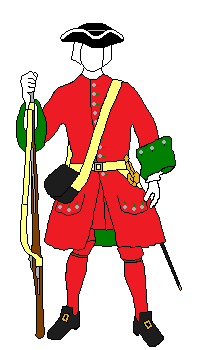 |
According to Höglund/Bespalov
1700:
K-G. Ivanitski (Evans/Evens?)
1701: I. Sak
1703: M. Bordovik
1704: Ogilvie
1706: Georgii
|
| |
1700: Gustav
Ivanitsky
1701: Ivan Sak
1701: Matvey Bordovik
1704: Georg Benedict Ogilvy
1707: Heinrich-Friedrich Frize
|
|
1701 |
One white colour and
nine greyish green colours. |
1709
Red coat with pewter buttons, green lining
and cuffs, hat with white lace. Vest, breeches, stockings, neckcloth
and cloak red.
1711
Red coat with yellow lining, cuffs and
button holes, red karpus with yellow lining. Another source states:
red coat with pewter buttons and blue lining and cuffs, red
karpus with blue lining.
1712
Green coat, green karpus, red breeches,
green cloak.
1714
Red coat, leather breeches, blue cloak.
1716
Green coat, red karpus.
1717
Red coat. |
|
1707 |
The Tsar ordered white
coats with red cuffs. |
|
1709 |
Breeches of red cloth
and leather, hat, black neckcloth. |
|
1711 |
Red coat, red karpus
with blue lining. |
|
1712 |
Coat, dark green cloak
and karpus, red breeches, black neckcloth, dark green-yellow fourier
pennants. |
|
1714 |
Red coat, leather
breeches, red cloak |
|
1715 |
Blue karpus |
|
1716 |
Dark green coat, red
cloak. |
|
1717 |
Coat red (or maybe just
the facings), red karpus, blue breeches, red cloak. |
|
1718 |
Green coat, green and
red
karpus, red cloak. |
|
1720 |
Red karpus |
Narva 1700, Arkhangelsk 1701-02, Gemäuerthof 1705, Grodno 1706,
Akhtyrska, Oposhna, Poltava 1709, Riga 1710, Prut 1711, Pälkäne 1713,
Storkyro 1714, Stäket 1719. |
|
Narvski
(raised 1704 in Moscow by volunteers and
conscripts)
According to Boris Megorsky
|
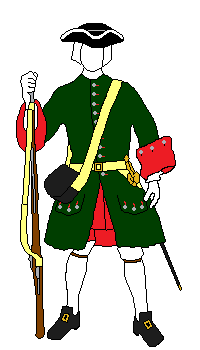 |
According to
Höglund/Bespalov
|
| |
1704: Adam
Schonback
1705: Gavrilo Golovkin
|
1704:
A. von Schönbeck
1706: G. Golovkin
170?: S. Sukin
|
|
1710 |
Dark green coat with red
cuffs and pewter buttons with emblem, red breeches, red cloak,
boots, black hat trimmed with white linen. |
|
1711 |
Dark green coat, red
breeches and cloaks, hat. |
1711
Green coat with red lining and cuffs,
black hat, leather breeches or red cloth breeches, red stockings,
red cloak |
|
1712 |
Green coat, red breeches,
white stockings, red cloak, hat. |
|
1713 |
Blue coat, white vest,
white breeches, hat with lace, black neckcloth. |
|
1714 |
Red cloak. |
|
1716 |
Blue coat with red cuffs
and lining, hat. |
|
1718 |
Blue coat, leather
breeches, red cloak. |
|
1720 |
Green coat with red
cuffs and lining, hat. |
Narva 1704, Gemäuerthof and Mitau 1705, Poltava 1709, Riga and
Viborg 1710, Pomerania 1712-14, garrison in Narva from 1714. |
Nevski
|
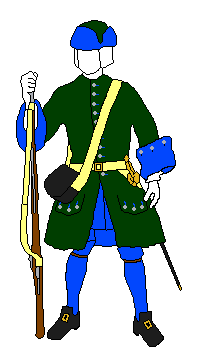 |
According to Angus Konstam
(raised 1702-03 but completed first
1706)
1706: Kulikov
According to
Höglund/Bespalov
(raised 1706 in Saint Petersburg with
men from other regiments)
1706: Kulikov
170?: V. Zaborovski
Unknown uniform |
According to Boris Megorsky
(raised 1713 in Kiev) |
|
1717 |
Karpus. |
|
1719 |
Dark green coat, blue
breeches, red cloak. |
|
1722 |
Green coat, red and blue
vest, leather breeches, red cloak. |
Höglund/Bespalovs regiment: Garrison in Saint Petersburg
1706-09, Poltava 1709, Viborg and Kexholm 1710, Pälkäne 1713, Storkyro
1714, Stäket 1719. |
|
Nizhegorodski
(raised 1700 in Moscow through conscription)
According to Boris Megorsky
|
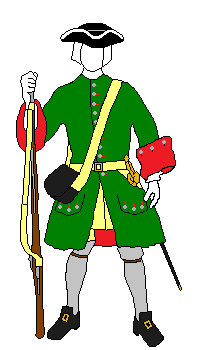 |
According to
Höglund/Bespalov
|
| |
1700: Astafy Pohlman
1701: Michael Strausberg
1703: Denis Ridder
1706: Effren
1707: Arot Pfeilenheim
1707: Hartwig-Friedrich Nostitz
|
1700: A. Bolmann
(Pohlman)
1701: M. von Strauchberg
1702: D. Ridder
1706: I. Lignetz |
| 1700 |
Cherry coat (dark red, almost brown). |
1700
Green coat.
1708-11 Green coat, hat or green karpus
with red lining, leather breeches, grey stockings.
1716
Green coat.
1717
Red coat with blue lining. |
| 1701 |
Ten cherry colours. |
| 1708 |
Red cloak. |
|
1711 |
Green coat, leather breeches, hat. |
| 1712 |
Green coat, green karpus with red
lining. One white colour, seven green colours. |
| 1714 |
Green coat, blue breeches. |
|
1717 |
Delivered: red coat
(silver lace for NCOs), blue breeches, blue and red cloak, red
karpus. Green coat, after September red with blue facings and three
buttons on the sleeve. |
|
1718 |
Red coat, leather
breeches, red and blue cloak |
Narva 1700, Hummelshof 1702, Nyenskans 1703, Jamburg 1703, Dorpat
1704, Narva 1704, Grodno 1706, Oposhna 1709, Poltava 1709, Riga 1710,
Prut 1711, Pälkäne 1713, Storkyro 1714, Hangö udde (Gangut) 1714,
Swedish east coast 1719. |
|
Novgorodski
(raised 1700 in Moscow through conscription)
According to Boris Megorsky
|
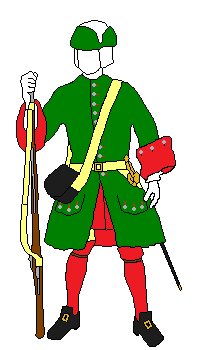 |
According to
Höglund/Bespalov
|
| |
1700: Nikolay
Balk
1705: Nikolay Goering
1707: Pfeilenheim
|
1700: N. Balk
1704: N. Göring
1707: J. von Fichtenheim |
| 1700 |
Red coat. |
1700
Green coat. 1709
Wore captured Swedish karpuses after the battle of
Poltava.
1711 Green coat with
red lining and cuffs, white karpus with green lining, black
neckcloth, red vest, red breeches, red stockings. |
| 1709 |
Hat or karpus according to Juel. |
| 1710 |
Leather breeches, shoes "kurpy"
with stockings. |
|
1711 |
Green coat, white karpus with green
lining. |
|
1712 |
Green coat, white karpus with green
lining, gaiters of tent linen. |
| 1714 |
Karpus. |
| 1717 |
Karpus. |
|
1719 |
Blue coat with red cuffs
and lining, karpus |
|
1720 |
Red cloak with brass
hooks and loops, karpus |
Narva 1700, Erastfer 1701, Hummelshof 1702, Jamburg 1703, Dorpat
1704, Narva 1704, Gemäuerthof 1705, Lesnaya 1708, Poltava 1709, Reval
1710, Riga 1710, Pomerania 1711-18. |
|
 Olonetski Olonetski
(Raised 1697 in Kazan from several
streltsy units, disbanded 1712)
Colonel: Alexander Scharf
Unknown uniform
Erastfer 1701, Hummelshof 1702, Nyenskans 1703,
Poltava 1709
|
|
 Pereyaslavski Pereyaslavski
(Raised 1704 in Nizhny Novgorod with
conscripts and Cossacks from the lower Volga, disbanded 1709)
1704: A. Topornin, 1708: W.
Fermor
Unknown uniform
Garrison in Smolensk and Polotsk 1704-08, garrison in Veprik 1708-09
and captured there by the Swedes. About 500 men were freed in the battle
of Starya Senchari and participated in the battle of
Poltava 1709.
|
|
Permski
(raised 1700 in Kazan through conscription)
According to Boris Megorsky
|
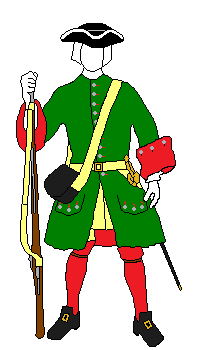 |
According to
Höglund/Bespalov
|
| |
1700: Ivan Angler
1701: Tomofey Treiden
|
1700: I. Angler
1701: F. Bachmanov
1703: T. Treiden
|
|
1707 |
Hat. |
1709
Green coat with yellow lining and cuffs, yellow
karpus with green lining. |
|
1708 |
Green coat with red
facings. |
| 1712 |
Green coat, yellow
karpus, light green cloak. |
|
1713 |
White coat and vest,
gaiters of tent linen, red neckcloth. |
|
1714 |
White coats and 87 red
coats (probably for NCOs), hat. |
|
1715 |
Red coat, leather
breeches,
green karpus, red neckcloth. |
|
1717 |
Blue cloak. |
|
1718 |
Red cloak, hat. |
|
1720 |
Hat. |
Erastfer 1701, Nöteborg 1702, Hummelshof 1702, Nyenskans 1703,
Jamburg 1703, Dorpat 1704, Narva 1704, garrison in Dorpat, Narva and
Kronslott 1704-06, Grodno 1706, Poltava 1709, Riga 1710, Viborg 1710,
Pomerania and Mecklenburg 1711-18. |
|
Pskovski
(raised 1700 in Moscow through
conscription)
According to Boris Megorsky
|
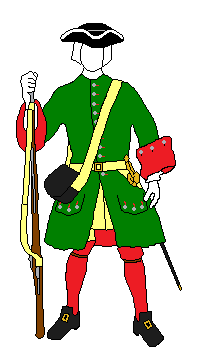 |
According to
Höglund/Bespalov
|
| |
1700: Ivan Mews
1707: Peter d'Albonne
|
1700:
K. Gulitz
1701: I. Mevs
1706: von Dalbon (d'Albonne?)
1706: W. von Fenniksbirs1711
Green coat, hat.
1712
Green coat, hat, red breeches or leather
breeches, light grey gaiters made of old tent canvas.
1714
Green coat with red cuffs, blue karpus
with red lining.
1717
Red coat with yellow cuffs, blue cloak. |
|
1700 |
Light blue coat. |
|
1711 |
Green coat, hat, karpus. |
|
1712 |
Green coat, hat, leather
vest, leather breeches, red cloak with blue lining, karpus. One
white colour with emblems and seven azure colours. |
|
1713 |
Red coat, yellow karpus,
blue cloak |
|
1714 |
Karpus |
|
1717 |
Red coat with yellow
facings, green karpus, blue cloak. |
Narva 1700, Erastfer 1701, Hummelshof 1702, Nyenskans 1703, Narva
1704, Dorpat 1704, Gemäuerthof 1705, Grodno 1706, Malatitze 1708,
Oposhna 1709, Poltava 1709, Riga 1710, Viborg 1710, Prut 1711, Pälkäne
1713, Storkyro 1714, Stäket 1719. |
|
Rostovski
(raised 1700 in Kazan by volunteers)
According to Boris Megorsky
|
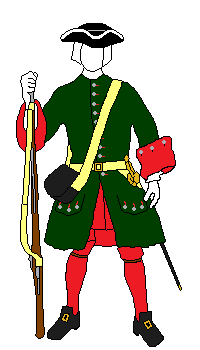 |
According to
Höglund/Bespalov
|
| |
1700: Kaspar
Goulitz
1706: Nikolay von Werden
1706: Ivan Chambers
|
1700: K. Gulitz
1704: J. Chambers
1706: I. Golovin
|
|
1705 |
Red colours. |
1711
Green coat with yellow cuffs, hat, red breeches, grey
cloak. |
|
1707 |
The Tsar ordered
manufacture of green coats. |
| 1710 |
Dark green coat,
leather breeches, homespun grey cloak, hat. |
|
1711 |
Dark green coat, red
breeches, homespun grey cloak. |
|
1712 |
Green coat, breeches red
and leather, hat. Had a white colour with eagle and seven red
colours which were replaced by a white colour with eagle and seven
light blue colours. |
1712
Green coat, hat. |
|
1714 |
Green coat with red
cuffs for privates and gold lace for NCOs, red coat with blue cuffs
and silver lace for clerks, blue breeches, blue cloak with red
lining, green karpus with red lining, red neckcloth. |
|
1717 |
Green coat, leather
breeches,
blue cloak, green karpus. |
|
1720 |
Green coat, leather
breeches,
hat. One white and seven light blue colours. |
Düna 1701, Nöteborg 1702, Marienburg 1702, Nyenskans 1703, Narva
1704, Grodno 1706, Holowczyn 1708, Poltava 1709, Riga 1710, Prut 1711,
Pomerania 1712, naval infantry 1714-18. |
Ryazanski
According to Boris Megorsky
(raised 1703 in Ladoga from chosen men of three regiments)
|
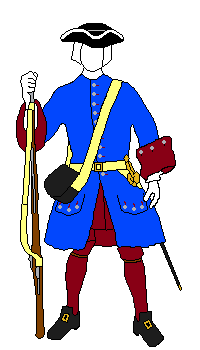 |
According to
Höglund/Bespalov
(raised 1703 in Moscow by volunteers)
|
| |
1703: Daniil
Cooper
1705: Nikolay Lang
|
1703:
D. Kuper (Cooper?)
1705: N. Lange
170?: J. von Ravenstein1711
Green coat, black hat.
1717
Blue coat. |
|
1704 |
Blue coat; breeches and
vest cherry. |
|
1711 |
Green coat, karpus. |
|
1712 |
Green coat, hat. |
|
1713 |
Blue coat, karpus. |
|
1716 |
Karpus. |
|
1717 |
Blue coat with red
facings. |
|
1719 |
Red coat, green karpus. |
|
1720 |
Blue cloak, leather
breeches. |
Gemäuerthof 1705, Holowczyn 1708, Poltava 1709, Prut 1711, Hangö
udde (Gangut) 1714. |
|
S:t Petersburgski
(raised 1703 in Saint Petersburg by volunteers from other regiments)
Colonel
Alexander Menshikov
Lieutenant Colonel: Nikolay Neitert (Netert, Neudgard?)
According to Boris Megorsky
|
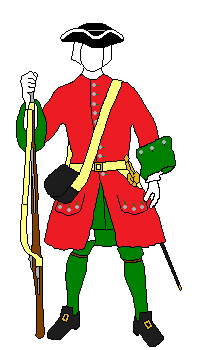 |
According to Höglund/Bespalov
(also
called the
Governor's Regiment) |
| 1706 |
Hat. |
|
1708 |
Hat. |
| 1711 |
Hat. |
|
1712 |
Red coat, green cloak. |
|
1713 |
Red coat, white breeches,
green cloak, white neckcloth. One white colour and seven reddish
colours. |
|
1714 |
Green cuffs, karpus,
white neckcloth. |
|
1716 |
Red coat, green vest,
blue breeches, green cloak, silver lace for NCOs. blue karpus. |
|
1717 |
Red coat with green
facing, green vest, blue karpus with red flaps. |
1717
Red coat. |
|
1718 |
Red coat, green vest,
red breeches, green cloak, white neckcloth. |
|
1719 |
Red coat, red breeches. |
|
1720 |
Karpus. |
Nyenskans and Systerbäck 1703, Oposhna and Poltava 1709, Reval,
Riga and Kexholm 1710, Pälkäne 1713, Storkyro 1714. |
|
Schlüsselburgski
(raised 1700 in Moscow by volunteers)
According to Boris Megorsky
|
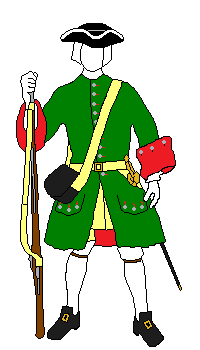 |
According to
Höglund/Bespalov
|
| |
1700: Matvey
Treiden
1702: Tikhon Gundertmark
1704: Yakov Kartashov
1704: Benedict Povish
1705: Zaborovsky
|
1702:
T. Gundertmark
1703: A. Schnewentz
1703: B. Povish
1705: Zaborski |
|
1711 |
Green coat, yellow karpus with red lining. |
1708
Green coat, leather breeches, hat. |
| 1711
Green coat, yellow karpus with red lining. |
|
1712 |
Green coat with red
cuffs, red neckcloth, green karpus with red lining, hats for NCOs,
pewter buttons, red breeches, white stockings. Fourier pennants of
green and red cloth. |
|
1714 |
Blue coat, karpus. |
|
1715 |
Blue coat, red cloak,
karpus. |
|
1716 |
Karpus. |
|
1717 |
Blue coat, red cloak. |
1717
Blue coat, red cloak. |
|
1718 |
Karpus |
| 1719 |
Blue coat, red cloak,
green karpus. |
|
1720 |
Knitted gloves for NCOs,
corporals and clerks. |
|
1722 |
Blue vest |
According to Megorsky the regiment that would become Schlüsselburgski
was split into two regiments 1702 (the other one became
Azovski). Höglund/Bespalov have recorded the regiment that existed
before the partitioning as a separate regiment, but apart from that they
do not have any diverging information about it.
Ingria and Estonia 1702-03, Narva 1704, Gemäuerthof
1705, Poltava 1709, Riga 1710, Kexholm 1710, Prut 1711, Pälkäne 1713,
Storkyro 1714, Hangö udde (Gangut) 1714. |
|
Sibirski
(raised 1700 in Moscow through conscription)
According to Boris Megorsky
|
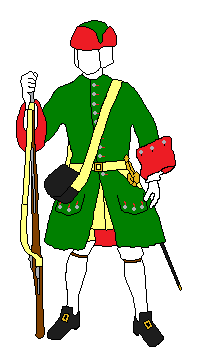 |
According to
Höglund/Bespalov
|
| |
1700: Irik von
Werden
1701: Mikhail Frank
1702: Ivan Angler
1706: Feodor Belling
|
1700: E. von
Verden
1701: M. Frant
1701: I. Angler
1701: F. Belling
1706: P. Leslie
|
|
1700 |
Green coat. |
1700
Red coat. |
|
1708 |
Green coat, leather
breeches, red and white stockings, "kurpy"-shoes, karpus, black
neckcloth.. |
| 1710 |
Homespun grey cloak,
boots. |
|
1711 |
Green coat, boots, hat. |
1711
Green coat, hat or green karpus, red vest, red breeches, red
neckcloth, green cloak. |
|
1712 |
Green coat, cloak and
karpus. One white colour and seven yellow colours. |
|
1714 |
Grey stockings. |
|
1715 |
Red coat, leather
breeches,
blue cloak, green karpus, white neckcloth. |
|
1717 |
Red coat with blue
facings, green vest, white neckcloth. |
1717
Red coat. |
|
1718 |
Red and green coat,
green cloak, red, green and blue karpus. |
|
1720 |
Karpus |
Narva 1700, Erastfer 1701, Hummelshof 1702, Jamburg 1703, Koporje
1703, Narva 1704, Dorpat 1704, Grodno 1706, Poltava 1709, Riga 1710,
Prut 1711, naval infantry 1713-, Åland 1715. |
Not mentioned by Boris Megorsky
According to
Angus Konstam
(raised 1708 and disbanded 1712)
|
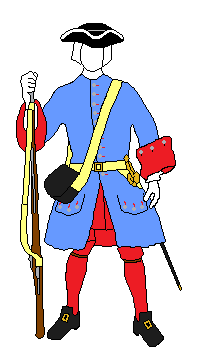 |
Simbirski
According to
Höglund/Bespalov
Raised 1702 in Smolensk from a streltsy
regiment
Colonel: I. Leslie
1707
Light blue coat.
Poland 1706, Courland 1708, merged with A. Gulitz' regiment
and created Simbirski Regiment 1708. |
|
Smolenski
(raised 1700 in Moscow through conscription)
|
According to Höglund/Bespalov
1700: T.
Gundertmark
1700: I. Bils
1710: I. Deniser
1715: T. von Fenedier (Venediger?)
|
According to Boris Megorsky
|
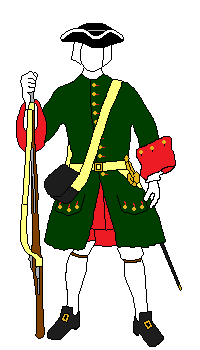 |
| |
1700: Ilya Bils
|
|
1701 |
Four straw yellow
colours. |
1707?
White coat with brass buttons, blue lining and cuffs,
white karpus with red lining, black neckcloth, grey vest, grey
breeches, grey/blue-striped stockings. |
|
1708 |
Dark green coat, red
vest, red breeches. One white colour and four "lemon" colours. |
|
1709 |
Dark green coat, red
vest, red breeches, hat, grenadier caps. |
|
1712 |
Red cloak, gaiters of
tent linen. |
1708
Green coat with red lining and cuffs, green karpus with red lining,
red vest, red breeches, white stockings, red neckcloth and cloak. |
|
1713 |
White coat with red
cuffs and lining, brass buttons, red vest, red neckcloth. One white
colour,
seven colours: "red with yellow". |
|
1714 |
86 red coats (probably
for NCOs). For recruits: grey coat, vest of coloured linen, cap of
red cloth, motley sash, white neckcloth. |
1715
White coat with pewter buttons, red lining and cuffs, hat with white
lace, black neckcloth, red vest, red breeches, white stockings. Red
coat for NCOs, grey coat for train drivers. |
|
1715 |
Dark green coat and
karpus, leather breeches, red neckcloth. |
|
1718 |
Dark green coat,
leather breeches, red cloak, hat, red neckcloth. |
|
1720 |
Leather breeches, red
cloak, hat. red neckcloth. |
Narva 1700, Erastfer 1701, Hummelshof 1702, Nyenskans 1703, Narva
1704, Suppressed rebellion in Astrakhan 1706 and garrison in Voronezh, Reval
1710, Viborg 1710 and garrison in Riga, Pomerania 1713-18. |
Rentzel
(raised by survivors from the battle of Fraustadt 1706)
Colonel: Samuil Rentsel
According to Boris Megorsky
Alternative name: Saksonsky (Saxon)
|
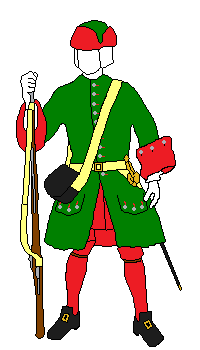 |
According to
Höglund/Bespalov Called Suzdalski
from 1718
|
|
1711 |
Green coat, green karpus
with red lining, pewter buttons, red breeches and stockings. |
1707-11
Green coat with red lining and cuffs, green karpus
with red lining, red vest, red breeches, stockings and black
neckcloth. |
| 1712 |
Green coat with pewter
buttons, red breeches and stockings, red neckcloth, green karpus
with red lining. Hat for NCOs. One white colour and seven red
colours. |
| 1714 |
Green coat, karpus, |
|
1716 |
Cloak with white collar. |
|
1717 |
Blue coat, karpus. |
|
1718 |
Blue coat. |
|
1719 |
Karpus, silver lace on
NCO coats. |
|
1720 |
Leather breeches. |
Holowczyn 1708, Oposhna and Poltava 1709, Riga 1710, Prut 1711,
Mecklenburg 1712-17, Copenhagen 1719. |
Tobolski
According to Boris Megorsky
(raised 1703 in Moscow through conscription)
|
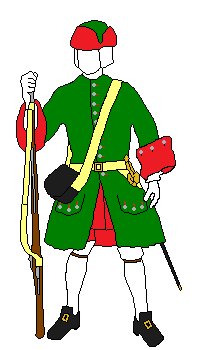 |
According to
Höglund/Bespalov
(raised 1703 in Moscow by volunteers)
|
| |
1704: Nikita
Repnin |
1703:
A. Repnin
1704: I. Chambers
1706: G. Golovkin
1707: I. Voikov
|
|
1705 |
Yellow colours. |
|
1706 |
High boots. Tsar
confirmed issuing seven black colours of silk. |
|
1711 |
Green coat, green karpus
with red lining. |
1711
Green coat with red lining and cuffs, green karpus with red lining,
red vest, red breeches, red stockings, black neckcloth. |
|
1712 |
Green coat with pewter
buttons, green karpus with red lining, hat for NCOs, red breeches,
white stockings, red neckcloth. |
|
1722 |
Green and white vest,
leather breeches, green cloak. |
Narva 1704, Grodno 1706, Holowczyn 1708, Poltava 1709, Prut 1711,
Hangö udde (Gangut) 1714. |
|
Troitski
(raised 1700 in Moscow through conscription)
According to Boris Megorsky
|
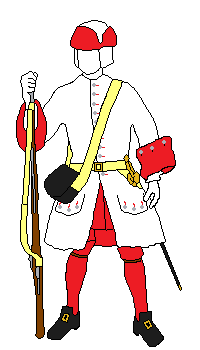 |
According to
Höglund/Bespalov
|
| |
1700: Matvey
Fliwerk
1701: Daniil Cooper
1701: Yury Abram
1702: Iov Abram
|
1700: M. Fliwerk
1704: Zdanov
1714: D. Kuler
|
|
1700 |
Green coat with dark
green facings. Green colours. |
1700
Green coat, red breeches. |
|
1708 |
White coat with red
facings. |
1708
White coat with red cuffs. |
| 1710 |
Dark green breeches,
dark green coat with red lapels and cuffs, 18 grenadier caps with
the same colours, fourier pennants in uniform colours. |
|
1712 |
Fourier pennants of red
and green cloth. |
|
1713 |
Karpus. |
|
1715 |
Karpus. |
|
1718 |
Green coat and karpus,
red cloak. |
|
1720 |
Blue breeches. |
Narva 1700, Erastfer 1701, Hummelshof 1702, Nöteborg 1703, Narva
1704, Poltava 1709, Reval 1710, Viborg 1710, Pälkäne 1713, Storkyro
1714. |
Tverski
(raised 1700 in Moscow by volunteers, disbanded 1712)
According to Boris Megorsky
|
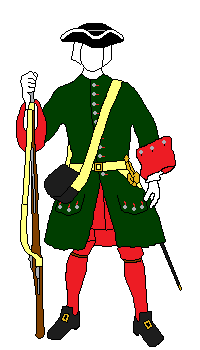 |
According to
Höglund/Bespalov
|
| |
1700: Karl-Peter
Dewson
1701: Yury Abram
1701: Daniil Cooper
1702: Alexey Kellen
|
1700:
K-P. Deveson (Devson, Devsen?)
1701: J. Abram
1701: D. Kuper
1702: A. Kellin |
|
1701 |
One white and seven "tausiny"
(dark blue) colours. |
|
1710 |
Dark green coat, red
breeches, hat, shoes and boots. |
|
1711 |
Dark green coat, red
breeches, hat. |
1711
Green coat with red lining and cuffs, red karpus, red
vest, red breeches, red stockings, black neckcloth. |
| 1712 |
When the regiment was
disbanded a set of one white and seven green colours were
transferred to Yaroslavski Regiment. |
Narva 1700, Erastfer 1701, Hummelshof 1702, Jamburg 1703, Dorpat
1704, Narva 1704, Grodno 1706, garrison in Poltava 1709, Riga 1710. |
Ustyuzhski
(raised 1702 in Smolensk from Ozerov's Streltsy Regiment which was
garrisoned there, disbanded 1712)
|
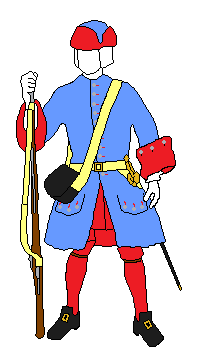 |
According to
Höglund/Bespalov
|
| |
1700: Ivan Ozerov
1707: Ivan von Mengden |
According to Boris Megorsky
|
|
1707 |
Azure coat. Two colours
of red and azure silk. |
1700
Light blue coat (kaftan?).
Garrison in
Smolensk 1702-08, garrison in Poltava during the siege. |
|
1708 |
Red cloak with yellow
lining. |
|
1712 |
White coat with blue
cuffs and pewter buttons, blue breeches, white karpus with green
flaps, black neckcloth. |
|
Velikolutski
(raised 1700 in Kazan through conscription,
was called Lutski 1708-10)
According to Boris Megorsky
|
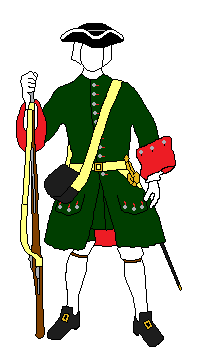 |
According to
Höglund/Bespalov
|
| |
1700: Nikolay von
Werden
1703: Alexey Deduit
After 1705: Gordon
?: Astafiev
|
1700:
N. von Verden
1702: A. Dedut
170?: A. Gordon
|
|
1705 |
Dark green colours. |
| 1711 |
Dark green coat, hat,
dark green vest, dark green breeches. According to Viskovatov: white
coat with blue cuffs, white karpus with red flaps. |
1711
White coat with blue lining and cuffs, white karpus
with red flaps. |
|
1712 |
Dark green coat, red
breeches. |
1712
Green coat, green vest, green breeches. |
|
1715 |
Dark green coat, karpus. |
17??
Green coat with blue cuffs, blue karpus, leather
breeches. |
|
1717 |
Dark green coat, karpus. |
1717
Green coat. |
Düna 1701, Nöteborg 1703, Nyenskans 1703, Narva
1704, in Poland 1704-06, Poltava 1709, Hangö udde (Gangut) 1714, Swedish
east coast
1720. |
|
Viborgski
(raised 1700 in Novgorod by volunteers and conscripts, got the name
Viborgski 1712)
According to Boris Megorsky
|
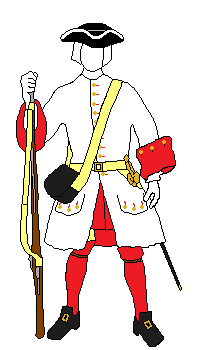 |
According to
Höglund/Bespalov
|
| |
1700: Ivan Kulom
1701: Andrey Inglis
|
1700:
I. Kulom (J. Colomb)
1701: A. Inglis
1708: S. Balabanov
|
|
1701 |
Three dark red colours. |
| 1709 |
Green coat for NCOs,
white coat for privates. |
1709/12
Green coat. |
|
1711 |
Green coat for NCOs,
clerks and oboist, white coat for privates, leather breeches, hat. |
|
1712 |
One white and seven blue
colours delivered. |
|
1714 |
Green coat with red
collar and cuffs, brass buttons, green karpus. |
|
1715 |
Green coat with red
collar and cuffs, brass buttons, green cloak, blue karpus. |
|
1716 |
Red vest, blue breeches,
1160 green cloaks with blue lining and 101 green cloaks with red
lining. NCOs: green coat with red collar and cuffs, blue lining and
white lace. Green karpus with blue flaps and white tape. |
|
1717 |
Green coat with red
collar, cuffs and lining, red vest, green karpus with blue flaps and
white tape |
1717
Green coat. |
|
1719 |
Red vest. |
|
1720 |
Green cloak, karpus. |
|
1721 |
Green vest. |
Narva 1700, Nyenskans 1703, Narva 1704, garrison in Narva and Ivangorod, Poltava 1709, Viborg 1710, Pälkäne
1713, Storkyro 1714, Stäket 1719. |
|
Vladimirski
(raised 1700 in Moscow through conscription)
1700:
Tomas Jungor,
1703: Vasily Poroshin (1704 according to Höglund/Bespalov)
According to Boris Megorsky
|
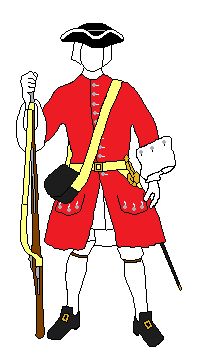 |
According to
Höglund/Bespalov
|
|
1700 |
Green coat. |
1700
Light blue coat. |
|
1703 |
Red coat, white vest,
white breeches, hat, grenadier bearskin caps with red top. One white
colour with eagle.. |
1702/03
Red coat with white lining and cuffs, hat, white vest,
white breeches, white stockings.
Höglund/Bespalov states that this regiment was merged with Saint
Petersburgski 1708
Narva 1700, Erastfer 1701, Hummelshof 1702. |
|
1705 |
Red coat, hat. |
|
1706 |
Red coat, hat. |
|
1707 |
Red coat, hat. |
|
1709 |
Stockings and shoes
delivered. |
| 1711 |
Red coat with white
cuffs and lapels. |
|
1712 |
Blue cloak. |
|
1713 |
White neckcloth.. |
|
1714 |
Green coat with red
cuffs and lining (including 80 coats with lace), leather breeches,
blue cloak, green karpus. |
|
1716 |
Red coat with red cuffs
and lining, green cloak, blue karpus. |
|
1719 |
Red coat with blue
lining
(including 80 coats with lace), leather breeches, blue cloak with
red lining and brass hooks and loops, blue karpus with red lining. |
|
1720 |
Leather breeches, blue
cloak. Eight black colours including one white with eagle. |
|
1721 |
Red coat, red and green
vests, red, blue and green cloaks. |
|
Vologodski
(raised 1700 i Novgorod by volunteers and conscripts)
According to Boris Megorsky
|
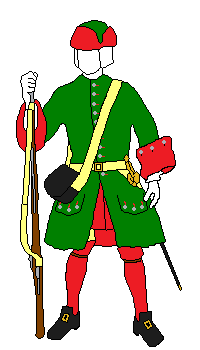 |
According to
Höglund/Bespalov
|
| |
1700: Roman Bruce
1702: Ivan Ridder
1704: Ivan von Buterer
|
1700:
R. Bruce
1701: I. Rider
1704: J. von Puterer
1705: Fliwerk
1706: Belleardi |
|
1705 |
Red colours. |
|
1709 |
Green coat, leather
breeches,
green karpus. |
| 1710 |
Grey cloak. |
|
1711 |
Green coat, grey cloak,
karpus. One red colour and one white colour. |
1711
Green coat, white karpus with green lining, grey
cloak. |
|
1712 |
Hats delivered. White
karpuses with green lining manufactured but probably not delivered. |
|
1715 |
Karpus. |
|
1717 |
Blue coat, blue cloak,
red karpus, white neckcloth. Green coat, red cloak. |
1717
Green coat, red cloak. |
|
1718 |
Blue and red coat,
leather breeches, red cloak, blue karpus. |
Narva 1700, Nyenskans 1703, Narva
and Dorpat 1704, garrison in Saint Petersburg 1704-05, Poltava 1709, Pernau
and Riga 1710, Pomerania 1711, Pälkäne 1713, Storkyro
1714, Hangö udde (Gangut) 1714, Stäket 1719. |
|
Voronezhski
(raised 1700 in Moscow by volunteers)
Colonel:
Friedrich Balk
According to Boris Megorsky
|
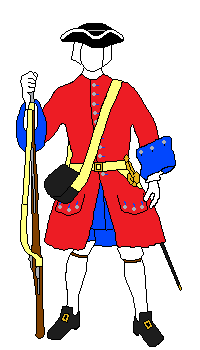 |
According to
Höglund/Bespalov
|
|
1709 |
Red coat, blue and white
breeches. |
1700
Red coat. |
| 1710 |
Dark green coat, dark
green breeches,
hat. |
|
1711 |
Dark green coat, vest
and breeches of chamois leather, green cloth breeches for NCOs,
white stockings, hat, red neckcloth. |
|
1712 |
Green coat, red karpus
with yellow lining. |
|
1713 |
Dark green coat,
chamois-leather breeches, blue cloak, green karpus. |
|
1714 |
Dark green coat, karpus. |
1714
Green coat. |
|
1716 |
Karpus, gloves |
|
1717 |
Red coat, green cloak. |
1717
Red coat, green cloak. |
|
1718 |
Blue breeches. |
|
1719 |
Red coat, red karpus. |
|
1720 |
Knitted gloves for NCOs,
corporals and clerks. |
Narva 1700, Erastfer 1701, Hummelshof 1702, Jamburg 1703, Dorpat
1704, Narva
1704, garrison i Dorpat 1704-09, Poltava 1709, Riga 1710, Pomerania 1711,
Stettin 1713, Storkyro
1714, Hangö udde (Gangut) 1714, Stäket 1719. |
|
Vyatski
(raised 1700 in Kazan through conscription)
According to Boris Megorsky
|
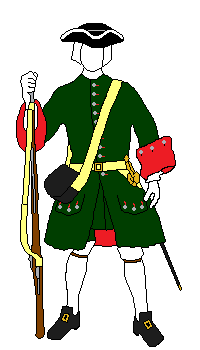 |
According to
Höglund/Bespalov
|
| |
1700: Pavel
Berner
1704: Alexander Sharf
1706: Ivan Schneberg
1706: Alexey Golitsyn
|
1700:
P. Berner
1706: A. Golitsyn |
|
1705 |
Ash grey colours. |
| 1711 |
Dark green coat, dark
green breeches,
hat. |
1711
Green coat with red lining and cuffs, hat, green vest,
green breeches, red stockings. |
|
1712 |
Green coat, white
stockings, hat. One white and seven black colours with gilded
finials. |
|
1713 |
Leather vest, gaiters of
tent canvas, hat. |
|
1714 |
Leather breeches, blue
cloak, green karpus. |
|
1717 |
Red cloak with yellow
lining, karpus. "Mecklenburg colours". |
|
1718 |
Hat with lace for NCOs.
Blue coat, vest, breeches and loops, white cuffs,
karpus. |
|
1720 |
Red cloak, karpus, hat
for NCOs. |
Nöteborg 1702, Nyenskans 1703, Narva
1704, Holowczyn 1708, Poltava 1709, Prut 1711, Tönningen 1713, Stettin,
Mecklenburg, Lüneburg 1712-14. |
Yamburgski
(raised 1705 from Vestov's Streltsy Regiment in Novgorod, disbanded
1712) |
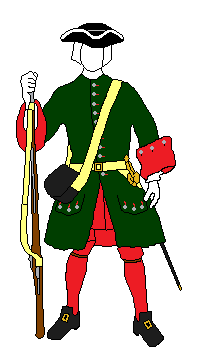 |
According to
Höglund/Bespalov
|
According to Boris Megorsky
|
| |
1705: Iakov
Vestov
|
1705:
Z. Vestov (West) Unknown
uniform
Bykov 1707, Poltava 1709, garrison in Kamenni Zaton. |
|
1707 |
Dark green coat |
| 1711 |
Dark green coat with red
cuffs, red breeches, red stockings, hat. Eight "smoke" (shade of
grey) colours. |
|
|
Yaroslavski
According to Boris Megorsky
(raised 1700 in Simbirsk with local soldiers)
|
According to
Höglund/Bespalov
(raised 1700 in Moscow by volunteers)
|
| |
1700: Philipp Kar
1701: Alexey Bolobonov
|
1700: I. Treiden
1706: A. Balabanov
1708: P. Apraxin |
|
1701 |
Light grey colours. |
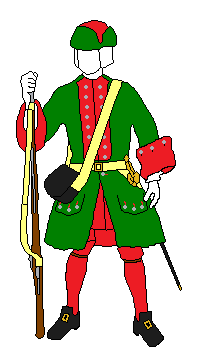 |
|
1703 |
Green coat, red breeches,
shoes, boots. |
|
1704 |
Green coat, red breeches.
Grenadier and drummer caps of green and red cloth. |
|
1705 |
Grenadier bearskin caps
with a red top of cloth. |
|
1706 |
Grenadier and drummer
caps of cloth embroidered with silk. |
|
1707 |
Drum belts red with metal
lace. |
|
1708 |
Green coat with red
cuffs and lapels, red vest, red breeches. |
| 1709 |
Green karpus with red
flaps, brass buttons, "kurpy" shoes. |
|
1711 |
Red karpus for recruits. |
|
1712 |
Green cloak, "kurpy"
shoes,
blue stockings. One white colour with eagle and seven green colours
from the disbanded Tverski Regiment. Coats for train drivers and
servants grey with green facings. |
|
1713 |
White coat and vest,
chamois leather breeches
and later blue, gaiters of tent linen, hat. |
|
1714 |
White stockings, shoes,
boots. |
|
1715 |
Blue coat and karpus,
leather breeches, red neckcloth. 32 coats for NCOs with two rows of
silver lace, 48 coats for corporals with one row of silver lace. |
|
1717 |
Grey stockings, red
cloak with yellow lining. |
|
1718 |
Mecklenburg uniforms:
karpus, hat with lace for NCOs, blue coat, vest and breeches, white
cuffs and loops. |
|
1720 |
Uniforms issued in
Mecklenburg: Blue coat, red cloak, karpus, hat for NCOs. |
According to Höglund/Bespalov Yaroslavski had in
1703: Green coat with red lining and cuffs, red vest, red
breeches. Narva 1700, Erastfer 1701, Hummelshof 1702, Nyenskans 1703, Poltava 1709,
Viborg 1710, Reval 1710, Pomerania 1711-18, Hanover 1719. |
|
Other
Russian Infantry Regiments
These short-lived line regiments and garrison regiments never got
provincial names. The same thing applies for the auxiliary corps
that was sent to help Saxony 1704-06 which is listed further down.
| |
Colonel |
Origin |
Uniform |
History |
|
45 |
1698: Andreij Scharf
1702: F. Tolbuchin |
Raised 1697/98 in Tsaritsyn with
streltsies from Kazan military district. |
1708: hat, red coat, red breeches. |
Erastfer 1701, Jamburg 1703, garrison
in Saint Petersburg and Retusaari from 1704. |
|
46 |
1700: G. Jankovski
1701: M. Gurick
1704: P. Ostrovski |
Raised 1700 in Simbirsk with men from Shepelev's
old regiment. |
Unknown uniform |
Ingria, Estonia and on the Ladoga
1701, garrison in Saint Petersburg and the island Kotlin (Retusaari)
from
1704. "Saint Petersburg Garrison Regiment" 1712. |
|
47 |
1700: R Apraxin
1703: Schachovski
1707: Kulikov
|
Raised 1700 in Moscow by volunteers. |
1708 blue coat with red cuffs |
Narva 1704, Poltava 1709, Viborg and
Kexholm 1710.
Merged with Galitski 1712. |
|
48 |
1700: A. Zei (Tsey)
1701: G. Kreik
1702: I. Busch
1702: G. Kreik |
Raised before 1700 in Smolensk
through conscription. |
Unknown uniform |
Garrison in Smolensk 1700-08, at
Reval 1709. Probably disbanded that year. |
|
49 |
1699: A. Gulitz
1700: A. Voznitsyn |
Raised 1698-99 in Sevsk through
conscription from old regiments. |
Unknown uniform |
Garrison in Sevsk, Akhtyrka and other
places 1700-05. Mazepa's corps in Poland 1706. Probably disbanded
that year. |
|
50 |
1700: F. Kar (Carr?)
1703: A. Balabanov
1706: V. Polandianov |
Raised 1700 in Kazan with soldiers
from Bordovik's regiment as core. |
Unknown uniform |
On Ladoga, Ingria and Estonia
1701-04. Disbanded 1706. |
|
51 |
1700: I. Tirtov
1702: T. Gundertrmark |
Raised 1700 in Kazan with soldiers
from Bordovik's regiment as core. |
Unknown uniform |
Erastfer 1701, naval infantry on
Peipus 1701-02. Disbanded 1703. |
|
52 |
1701: O. Bulgakov
1706: K. Nekludov |
Raised 1701 in Belgorod from Bulgakov's
old streltsy unit. |
Probably streltsy uniform |
Garrison unit 1701-03, Apraxin's
campaign 1703, Reval 1710. Disbanded 1712. |
|
53 |
N. Cunningham |
Raised 1702/03 |
Unknown uniform |
In Poland and Saxony 1704-05, in Astrakhan
1706, garrison in Kazan 1712-21. |
|
54 |
A. Krivtsov (Krivtsovski) |
Raised 1703 in Moscow through
conscription. |
Unknown uniform |
In Kiev 1703, Poland until 1707,
land militia unit in Ukraine 1713. |
|
55 |
1703: F. Loshakov
1703/04:
G. Titov
1704:
S. von Fichtenheim
1709: Jurlov |
Raised 1703 in Moscow by volunteers.
|
Unknown uniform |
Narva 1704, Kolkanpää 1708, garrison
in Poltava 1709, Reval and Viborg 1710, garrison in Narva and Saint
Petersburg 1710-12. Disbanded 1712. |
| 56 |
1704: M. Nekludov
1711: Neelov |
Raised 1704 in Dorpat with personnel
from all military branches in Pskov's military district. |
1709/12: grey coat? |
Narva 1704, Oposhnaya 1709, Poltava
1709, Reval 1710, Viborg 1710. "Viborg Garrison Regiment" 1712 |
|
57 |
1704: A. Karr
1704: I. Hamilton
1708: Biltz |
Raised 1704 in Moscow by volunteers
and conscripts from Siberia. |
Unknown uniform |
Retusaari 1705, garrison in Saint
Petersburg 1706. Disbanded 1712. |
| 58 |
1704: V. Zaborovski
1710: S. Kozodavlev
1711: M. Chemesov |
Raised 1704 in Moscow with volunteers
and conscripts from Siberia. |
Unknown uniform |
Garrison in Saint Petersburg 1705, Kolkanpää 1708, Viborg 1710.
Disbanded 1712. |
|
59 |
Schnewenz |
1708 |
Hat, green coat,
brown breeches. |
Only Angus Konstam
mention this regiment. |
|
60 |
Sotovski |
1708 |
|
Only Angus Konstam
mention this regiment. |
|
61 |
Fraser |
1708 |
|
Only Angus Konstam
mention this regiment. |
|
62 |
Schmidt |
1708 |
Hat, dark green coat,
brown breeches. |
Only Angus Konstam
mention this regiment. |
|
63 |
Zotov (Zotoff) |
|
1709: feuille-morte coloured coat
with blue cuffs. |
Governor's Regiment in Narva (?) |
|
|
|
|
  Russian
Auxiliary Corps to Saxony Russian
Auxiliary Corps to Saxony
1704-06
According to Höglund/Bespalov this auxiliary corps
included 17 regiments which consisted of more than 10,600 men plus
officers. Vlad Velikanov's blog
Oderint dum probent have however conflicting information and
states a strength for the corps of 11 regiments which together with a
corps staff consisted of 9,852 men. In any case this original force
would be reorganised during its stay in Saxony 1705 to just 8 regiments
consisting of 6,300 men. This force was largely annihilated in the
battle of Fraustadt and the survivors created
Rentzel's Regiment (also called the Saxon
Regiment) which is recorded above.
Only Höglund/Bespalov have uniform data for these
regiments. Two combinations were worn by more than one regiment and it
is these that are illustrated in the two images here. They are referred
to has uniform A and uniform B in the table below.
When the corps was reorganised to eight regiments
in 1705 (called: Schöpping, Belling, Patkul, Holstein, Bilits, Gulitz
and Arnstedt as well as streltsies commanded by Cadeus), they were also
issued new uniforms. The sources have conflicting information
about them. The coats were either white, green or both. In any case
these uniforms were turned inside out in the battle of Fraustadt so that
the red lining would make them look like Saxons.
| |
Colonel |
History |
Uniform |
Höglund/ Bespalov |
Vlad Velikanov |
| 64 |
1700: Zacharias Crow
1701: Denis Bils (Biltz) |
|
Uniform A |
800 men |
956 men |
|
65 |
1700: Peter von Bukovin
(von Buxhövden)
1703: P. Livingston
(Leviston, Lewison) |
Raised 1700 in Kazan through
conscription.
Nöteborg 1702, Fraustadt 1706. |
Hat, green coat with pewter buttons,
red cuffs and lining, white vest, leather breeches, green stockings. |
310 men |
979 men |
|
66 |
A. Romanovski |
Raised 1700 in Kazan.
Düna 1701, Nöteborg 1702, Nyenskans 1703,
Fraustadt 1706. |
Hat, green coat with brass buttons,
red cuffs and lining, white vest, white breeches, blue stockings. |
696 men |
895 men |
|
67 |
Kanishev |
Raised 1700 in Sevsk from streltsies,
volunteers and old soldiers (garrison in Sevsk 1700-03). |
Uniform B |
1000 men |
|
|
68 |
I. Nelidov |
Same as Kanishev above, disbanded
1711 (raised in Sevsk autumn of 1703 according
to Vlad Velikanov). |
Hat, green coat with pewter buttons,
white cuffs and lining, leather vest, white breeches, red stockings. |
1000 men |
865 men |
|
69 |
E. Goltz (Gulits) |
Same as Kanishev above
(raised in Sevsk autumn of 1703 according to Vlad Velikanov). |
Uniform B |
400 men |
937 men |
|
70 |
Duke of Holstein-Plön
(commander: G. Erholni) |
Raised 1703 in Moscow by volunteers
and conscripts. (raised in Sevsk autumn of
1703 according to Vlad Velikanov).
Poland 1703-07, Fraustadt 1706, garrison in
Kiev 1711-18. |
Uniform A |
800 men |
985 men |
|
71 |
1703: E. von Delden
(= Vlad Velikanovs "Herman Deldin"?)
1706: L. Hallart |
Raised 1703 in Moscow by volunteers
and conscripts.
Garrison in Kiev 1703, Warsaw 1704,
Fraustadt 1706, garrison in Voronesh and suppressed Cossack
rebellion 1708, Pomerania 1711-12. |
Uniform A |
700 men |
919 men |
|
72 |
Belikov (Belling) |
Raised 1703, otherwise the same as
Kanishev above. |
Hat, green coat with pewter buttons,
red cuffs and lining, leather vest, leather breeches and red
stockings. |
400 men |
|
|
73 |
Kro
(= Vlad Velikanovs "Krikowskiy" which was raised during the winter
1703-04 in Moscow?) |
Uniform A |
800 men |
942 men |
|
74 |
Polentz |
Uniform A |
800 men |
|
|
75 |
Sytin |
Uniform A |
350 men |
|
|
76 |
von Patkul
(commander: Rentzel) |
Uniform A |
1000 men |
|
|
77 |
Buturlin
(= Vlad Velikanovs "Baturyn" which was newly
raised?) |
Uniform A |
300 men |
972 men |
|
78 |
Dedyt |
|
Hat, green coat with brass buttons,
red cuffs and lining, white vest, white breeches, red-grey-striped
stockings. |
300 men |
|
| * |
Danilov |
Streltsy regiment from Sevsk.
(was according to Vlad Velikanov a regular infantry regiment which
had been raised in Sevsk autumn of 1703). |
Red cap trimmed with fur, red coat
with brass buttons, green lining, leather vest, leather breeches,
boots. |
500 men |
910 men |
| * |
Kahovski
(= Vlad Velikanovs "Kakhowskiy"?) |
Streltsy regiment from Smolensk |
Green cap trimmed with fur, green
coat with brass buttons and red lining, leather vest, leather
breeches, boots. |
500 men |
438 men |
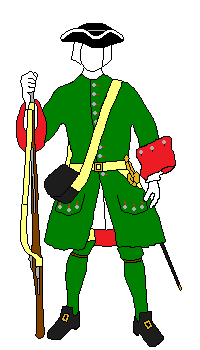
65. Levistons |
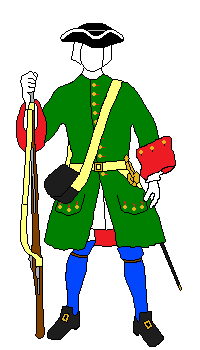
66. Romanovski |
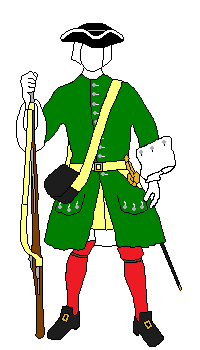
68. Nelidov |
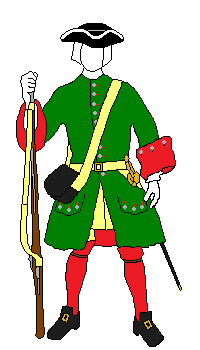
72. Belikov |
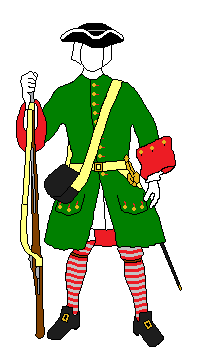
78. Dedyt |
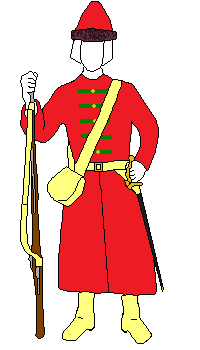
Danilov |
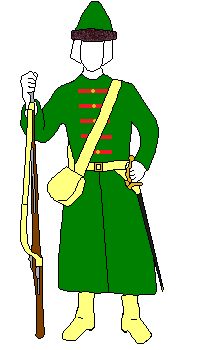
Kahovski |
Read also about
Russian cavalry uniforms. |
|
References
Höglund, Lars-Eric – Sallnäs, Åke – Bespalov, Alexander. Stora
nordiska kriget 1700-1721, III. Karlstad (2004)
Konstam, Angus. Peter the Great's army (1-2). London (1993)
Megorsky, Boris. The Russian Army in the Great Northern War 1700-21.
Warwick (2018) |
|

